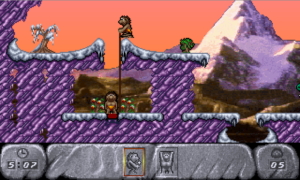The basic injustice of this blog is that the amount of attention a game receives is proportional to the time it takes me to finish it, not how significant or interesting it is. In fact, the less interesting a game is, the more likely I am to play it in short sessions, dragging it out. Thus, a sprawling mediocrity like The Humans gets two full weeks of posts, while its fellow puzzle-platformer Braid gets only one. But I have vague plans to return to Braid someday, to give it amore thorough analysis, whereas I’m pretty sure that this is my last post about The Humans.
Towards the end, the Witch Doctor pretty much disappears, presumably because it makes things too easy if you can have a rope at the very beginning. The rope is definitely the one tool that has the biggest impact on where you can go in this game. Most challenges can be reduced to alternately stacking Humans, and using the rope to haul everyone up to the platform that the stack let you reach (or, conversely, using the rope to let everyone down to a lower platform, then forming a stack to get the rope bearer down.) The only thing wrong with this approach is that it’s so time-consuming, and many of the later levels attempt to create difficulty by making their time limits low.
In fact, I found the hardest level in the game to be level 159, the second-to-last one, simply because it had such a tight time limit. The last level has a limit of 9:59, the maximum the game is capable of displaying, and seems to be included more or less to close things off with a nice pleasant experience, a reward to the player for coming that far. 159’s limit, even on Easy difficulty, strains things enough that I honestly wonder if it’s a mistake. There’s an obvious route to victory, and I suppose it might be possible to execute it in time given lots of practice and clever optimizations, but this would make it take time and effort way out of proportion to the rest of the game. Instead, I hit on the gimmick of leaping halfway into a bush from a platform slightly higher than it; once there, I could walk the rest of the way through it, which spared me the time I would have needed to fetch a torch. There was an earlier level that involved jumping over a bush in a similar way, but there, I cleared it completely. The messiness of winding up embedded in an obstacle makes it seem like a glitch, but who knows? It could just be the game’s last mean trick.
And yes, the needs-more-QA moments continued to the end. There was a level that exhorted me to “find the idol”, but which instead used the queen as a reward. There was a level that ended with the pet-dinosaur cutscene, despite not having any pet dinosaur in it — this was the only cutscene I had seen in the Jurassic levels, so it seems like the mistake is that it’s there at all, rather than that it’s the wrong one. Also, there’s one major glitch I failed to mention in my post on glitches: on Swamp-themed levels, where the floors are uneven, one sometimes falls through them when jumping. I wonder if the Amiga version had these problems too, or if it’s all a matter of hasty porting.
Speaking of cutscenes, there is in fact an outro scene, despite my doubts. Predictably, it riffs on 2001. And, having seen it, I’m well and truly finished with this game. It’ll be a while before I get it out of my head, though; I’ve played enough of it this week that it’s started haunting my dreams. I’ll have to try to choose as my next game something capable of muscling it out of my head.
 Comments(0)
Comments(0)